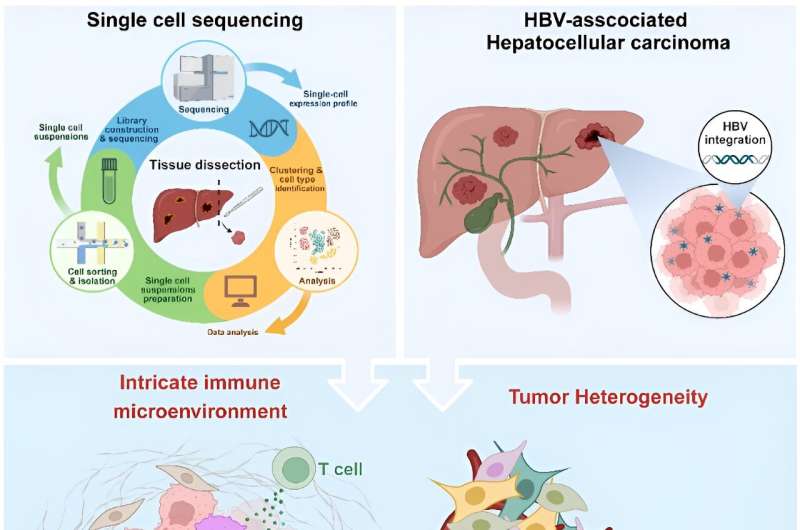This article has been reviewed according to Science X's editorial process and policies. Editors have highlighted the following attributes while ensuring the content's credibility:
fact-checked
proofread
Novel insights into HBV-hepatocellular carcinoma at single-cell sequencing

HBV-related HCC poses a significant global health challenge, characterized by its cellular diversity and complex tumor immune microenvironment. The increasing unmet need in HBV-HCC treatment highlights the need for a deeper understanding of the role of the intricate immune microenvironment, tumor cell plasticity, and dynamics of tumor evolution in HBV-associated hepatic carcinogenesis.
Single-cell sequencing has emerged as a revolutionary tool in cancer research, providing a comprehensive picture of the cancer's progression and the diverse pathways involved. The application of single-cell sequencing in HBV-HCC has been instrumental in dissecting tumor immunosuppressive microenvironment and heterogeneity, offering an unprecedentedly detailed insight into the HBV-HCC tumor ecosystem.
A new review published in MedComm—Oncology commences with an overview of the progress made in HCC research through scRNA-seq analysis, and systematically introduces the basic workflow, limitations, and improvements of scRNA-seq. One of the focal points of this review is how scRNA-seq has enhanced our understanding of malignant tumor cell heterogeneity in HBV-HCC.
Tumor heterogeneity serves as a pivotal support for the survival and further evolution of HBV-HCC under various selective pressures. The lack of understanding of ITH in HBV-HCC has existed as a tough issue for many years. scRNA-seq has revolutionized the exploration of tumor heterogeneity in HBV-HCC, opening up a range of new avenues to visualize intratumoral and intertumoral heterogeneity, monitor tumor progression, and prevent further cellular deterioration.
The study of the genetic diversity and clonal structure of tumor cells within HBV-HCC by single-cell sequencing not only lays a theoretical foundation for precise clinical classification but also offers potential precise therapeutic options based on molecular characterization. This can facilitate the discovery of novel biomarkers for diagnosis and prognostic efficacy.
In addition to heterogeneity, the review emphasizes immune profiling within the HBV-HCC tumor microenvironment. Unlike other tumors, the cellular and molecular immune imbalance in HBV-HCC is notably complex.
On the one hand, TME of HBV-HCC is flooded with abundant antigen-presenting cells (APCs) and immune cells, in which suppressive immune cells and tumor cells drive the dysfunction of effector cells. On the other hand, liver injury induced by chronic liver inflammation upon prolonged exposure to HBV infection propels the dysregulation of TME.
scRNA-seq has shed light on the chaos and dynamics of the immune microenvironment, identifying various cell fractions exerting an influential role in the development of HBV-HCC, such as CD69+ CD103+ HBV-specific Trm cells, LAYN+ Tregs, CCL18+ M2 macrophages, LAMP3+ DCs and TANs. It proposed a possible implementation of immune escape mechanisms, contributing to the identification of potential immune targets and the improvement of immunotherapy.
This comprehensive review not only sheds light on the current state of HBV-HCC research but also charts a course for future investigations. It underscores the pivotal role of integrating single-cell data with other omics data in advancing our understanding and treatment of HBV-associated hepatocellular carcinoma.
This integrative approach is key to unraveling the complexity of HBV-HCC and developing more effective treatments. Finally, the authors summarize the current limitations and potential solutions of single-cell sequencing in HBV-HCC research.
This review serves as a pivotal resource for readers seeking novel insights into single-cell sequencing in HBV-related hepatocellular carcinoma (HBV-HCC) research. It methodically assembles the core analytical approaches currently employed in HBV-HCC single-cell studies, shedding light on the roles of various cellular subpopulations and the evolutionary dynamics of clones in the development and progression of HBV-HCC.
By presenting this information in a structured and accessible format, the review not only provides a valuable reference for future HBV-HCC investigations but also guides the scientific community toward deeper insights and more effective interventions in the battle against HBV-HCC.
More information: Dandan Yin et al, Novel insights into HBV‐hepatocellular carcinoma at single‐cell sequencing, MedComm—Oncology (2023). DOI: 10.1002/mog2.60



















